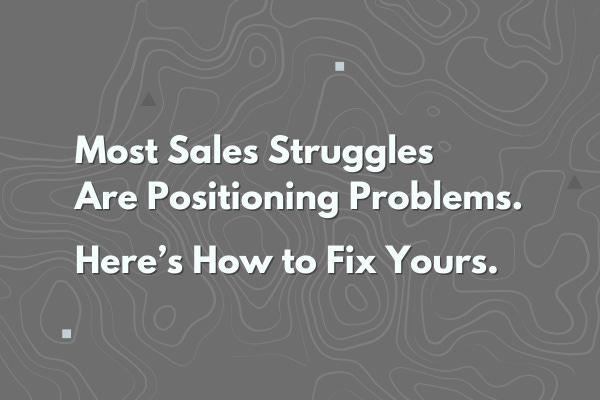Most Sales Struggles Are Positioning Problems. Here’s How to Fix Yours.
A few weeks ago, I posted something on LinkedIn that struck a nerve. It was about why most vendors think they have a sales problem, when in reality, they have a positioning problem. The response made it clear that this issue runs deeper than most realize.
Here’s the original LinkedIn post for reference:
Most vendors think they have a sales problem.
They don’t.
They have a positioning problem.
If a buyer doesn’t instantly get what you do, why it matters, and how it’s different, it doesn’t matter how many meetings you book.
They don’t have time to decode your pitch.
They won’t sift through jargon.
They won’t sit through a 30-slide deck trying to figure you out.
They’ll just move on.
That post resonated with a lot of people, but I realized it left an important question unanswered: how do you actually fix bad positioning? That’s why today we will drive into practical steps to make your positioning clear, compelling, and impossible to ignore.
Why Positioning is the Real Bottleneck
Sales struggles don’t usually come from a lack of effort or process. It’s not about the number of reps, the tech stack, or even the outreach strategy. If your sales motion feels like pushing a boulder uphill, it’s usually because:
Your value isn’t clear in the first 10 seconds (If buyers have to think too hard, they’ll move on)
You sound like everyone else (Generic messaging makes you forgettable)
Your buyers don’t see why they should care (They can’t immediately connect your solution to their problem)
That’s a positioning failure. And when positioning is weak, it makes every part of the sales cycle harder than it needs to be.
What Positioning Done Right Looks Like
Great positioning makes the next step obvious. Here’s a simple litmus test: Can a buyer repeat what you do in one sentence, without stumbling?
If not, your positioning is muddy.
Effective positioning:
Signals relevance immediately (Buyers know it’s for them)
Highlights the core pain you solve (Outcomes not Features)
Makes differentiation obvious (Not “better” but why you’re “different” in a meaningful way)
How to Fix Your Positioning
If your sales pipeline feels sluggish, stop tweaking tactics and start with these questions:
Clarity: If a non-expert read your website, could they explain what you do?
Relevance: Is your messaging focused on your customers’ problems or just your product?
Differentiation: If a buyer looked at you and two competitors, would they instantly see what makes you distinct?
Three Quick Fixes to Sharpen Your Positioning
If you’re struggling to answer these questions, here are three simple ways to start improving:
The Customer Confusion Test: Find three potential buyers (not investors, not colleagues but actual buyers). Send them your website headline, tagline, or elevator pitch. Ask them to explain it back to you in their own words. If they hesitate, ask questions, or say, “So you do X?”, your positioning needs work.
The "So What?" Test: Take your homepage headline, your LinkedIn tagline, or your pitch, and ask yourself: So what? Keep going until the answer is undeniable. Example:
"We provide AI-powered healthcare analytics."
So what?
"We help health plans predict high-cost members."
So what?
"We help health plans reduce unexpected costs by predicting high-cost members before they escalate."
Now, it’s obvious why it matters.
The One-Sentence Rule: Try explaining what you do in one short sentence without using any industry jargon. If it takes multiple sentences, or you start adding caveats, you’re still too complex.
Once you’ve gone through these three exercises, test your final messaging by asking five people outside your company to describe what you do after reading your homepage. If they hesitate, struggle, or get it wrong, you have more work to do.
Final Thought
Positioning isn’t just marketing fluff. It dictates how easy (or impossible) it is to sell. When it’s right, buyers lean in. When it’s wrong, no amount of sales hires, tech, or process tweaks will fix it. This idea sparked a lot of conversation on LinkedIn. If you want to see how others reacted (or add your own thoughts), check out the original LinkedIn post here.
🔒 Like This? Upgrade to a paid Subscription.
The free newsletter covers the big ideas. Paid subscribers get the full breakdowns, including client-tested strategy, behind-the-scenes examples, and deeper thinking you won’t find anywhere else.
→ [Become a Paid Subscriber]
About the Author
Ryan Peterson writes Upward Growth, where he shares practical insights on selling health tech into the payor market. With 15+ years in healthcare growth leadership, he focuses on helping vendors translate their value into traction with health plans.
🟦 Connect with him on LinkedIn.


